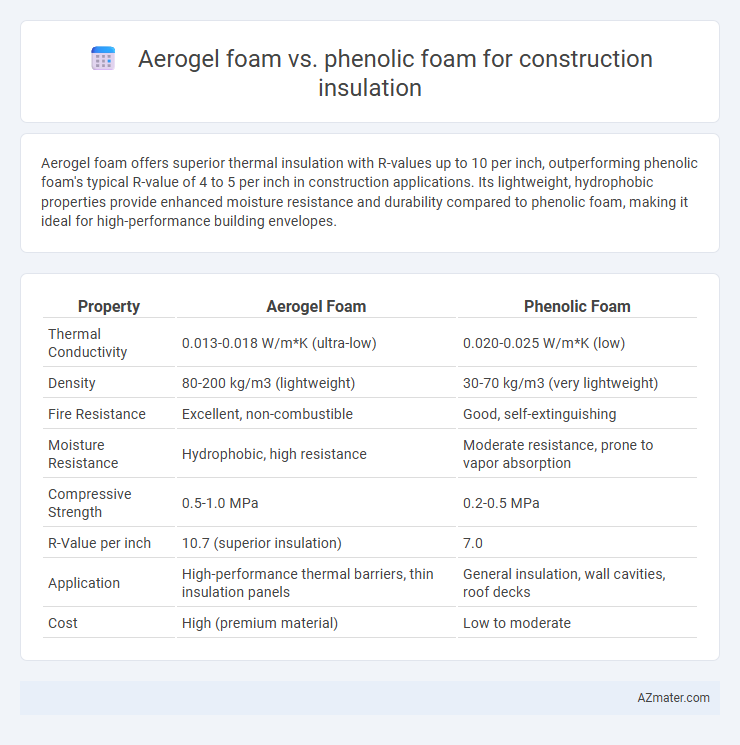Aerogel foam offers superior thermal insulation with R-values up to 10 per inch, outperforming phenolic foam's typical R-value of 4 to 5 per inch in construction applications. Its lightweight, hydrophobic properties provide enhanced moisture resistance and durability compared to phenolic foam, making it ideal for high-performance building envelopes.
Table of Comparison
| Property | Aerogel Foam | Phenolic Foam |
|---|---|---|
| Thermal Conductivity | 0.013-0.018 W/m*K (ultra-low) | 0.020-0.025 W/m*K (low) |
| Density | 80-200 kg/m3 (lightweight) | 30-70 kg/m3 (very lightweight) |
| Fire Resistance | Excellent, non-combustible | Good, self-extinguishing |
| Moisture Resistance | Hydrophobic, high resistance | Moderate resistance, prone to vapor absorption |
| Compressive Strength | 0.5-1.0 MPa | 0.2-0.5 MPa |
| R-Value per inch | 10.7 (superior insulation) | 7.0 |
| Application | High-performance thermal barriers, thin insulation panels | General insulation, wall cavities, roof decks |
| Cost | High (premium material) | Low to moderate |
Introduction to Construction Insulation Materials
Aerogel foam and phenolic foam are advanced construction insulation materials renowned for their superior thermal performance and fire resistance. Aerogel foam features ultra-low thermal conductivity, making it ideal for high-efficiency insulation in both commercial and residential buildings. Phenolic foam offers excellent fire retardancy and moisture resistance, providing a durable and safe solution for structural insulation in harsh environments.
What is Aerogel Foam?
Aerogel foam is an ultralight, highly porous material known for its exceptional thermal insulation properties, often outperforming conventional insulation materials like phenolic foam due to its low thermal conductivity around 0.013 W/m*K. Made primarily from silica, aerogel foam has a nanoporous structure that significantly reduces heat transfer, making it ideal for high-performance construction insulation where space and energy efficiency are critical. Its adaptability to various forms and resistance to moisture absorption further enhance its application in modern energy-efficient buildings.
What is Phenolic Foam?
Phenolic foam is a high-performance insulation material characterized by its closed-cell structure and excellent fire resistance, making it ideal for construction applications requiring stringent fire safety standards. It offers low thermal conductivity, typically around 0.020-0.025 W/m*K, resulting in superior energy efficiency compared to traditional insulation materials. Phenolic foam is also lightweight, rigid, and provides good dimensional stability, enhancing the durability and overall thermal performance of building envelopes.
Thermal Performance Comparison
Aerogel foam offers superior thermal insulation with a thermal conductivity as low as 0.013 W/m*K, significantly outperforming phenolic foam, which typically ranges around 0.020 W/m*K. This low thermal conductivity of aerogel foam results in thinner insulation layers achieving better energy efficiency in construction applications. Phenolic foam provides good fire resistance but cannot match the ultra-low heat transfer properties and overall thermal performance efficiency of aerogel materials.
Fire Resistance and Safety
Aerogel foam exhibits superior fire resistance compared to phenolic foam, maintaining structural integrity at temperatures exceeding 1,000degC due to its intrinsic inorganic composition and excellent thermal stability. Phenolic foam, while offering moderate fire retardancy, tends to char and release harmful smoke and toxic gases under high heat, which raises safety concerns in building applications. The enhanced fire safety profile of aerogel foam makes it a preferred choice for critical construction insulation where stringent fire codes and occupant safety are priorities.
Moisture and Water Vapor Resistance
Aerogel foam exhibits superior moisture and water vapor resistance compared to phenolic foam, making it highly effective in preventing condensation and mold growth in construction insulation. Its nanoporous structure allows for minimal water absorption while maintaining breathability, which enhances durability in humid environments. Phenolic foam, though offering moderate vapor resistance, tends to absorb more moisture over time, potentially compromising thermal performance and structural integrity.
Mechanical Strength and Durability
Aerogel foam provides superior mechanical strength and durability compared to phenolic foam, exhibiting higher compressive strength and enhanced resistance to mechanical deformation under load. Its nano-porous structure contributes to excellent dimensional stability and longevity in harsh environmental conditions, outperforming phenolic foam, which tends to become brittle and degrade over time. The enhanced durability of aerogel foam makes it a preferred choice for long-term insulation applications in construction where structural integrity is critical.
Environmental Impact and Sustainability
Aerogel foam offers superior thermal insulation with low density and minimal environmental footprint due to its high energy efficiency and long service life, reducing the need for frequent replacements and energy consumption in buildings. Phenolic foam features excellent fire resistance and low smoke emissions but often involves formaldehyde-based resins, raising concerns about VOC emissions and end-of-life disposal. Aerogel's recyclability and lower embodied carbon make it a more sustainable option for construction insulation compared to phenolic foam, which may have higher environmental impacts from production and chemical additives.
Cost-Effectiveness Analysis
Aerogel foam offers superior thermal insulation with R-values up to 10 per inch but comes at a significantly higher cost, often 5 to 10 times that of phenolic foam, which has R-values around 4 to 5 per inch. Phenolic foam provides a more budget-friendly solution with good fire resistance and moderate thermal performance, making it suitable for large-scale projects with cost constraints. Evaluating the lifecycle cost-effectiveness requires balancing the upfront material expense of aerogel against potential energy savings over time, whereas phenolic foam delivers reliable insulation with lower initial investment.
Choosing the Right Foam for Your Project
Aerogel foam offers superior thermal insulation with R-values up to 10 per inch and exceptional moisture resistance, making it ideal for projects requiring high-performance energy efficiency and slim profiles. Phenolic foam provides excellent fire resistance, dimensional stability, and cost-effectiveness, suitable for large-scale insulation with moderate thermal requirements and stringent fire codes. Selecting between aerogel and phenolic foams depends on project-specific factors such as thermal performance needs, budget constraints, fire safety standards, and installation space limitations.

Infographic: Aerogel foam vs Phenolic foam for Construction insulation
 azmater.com
azmater.com